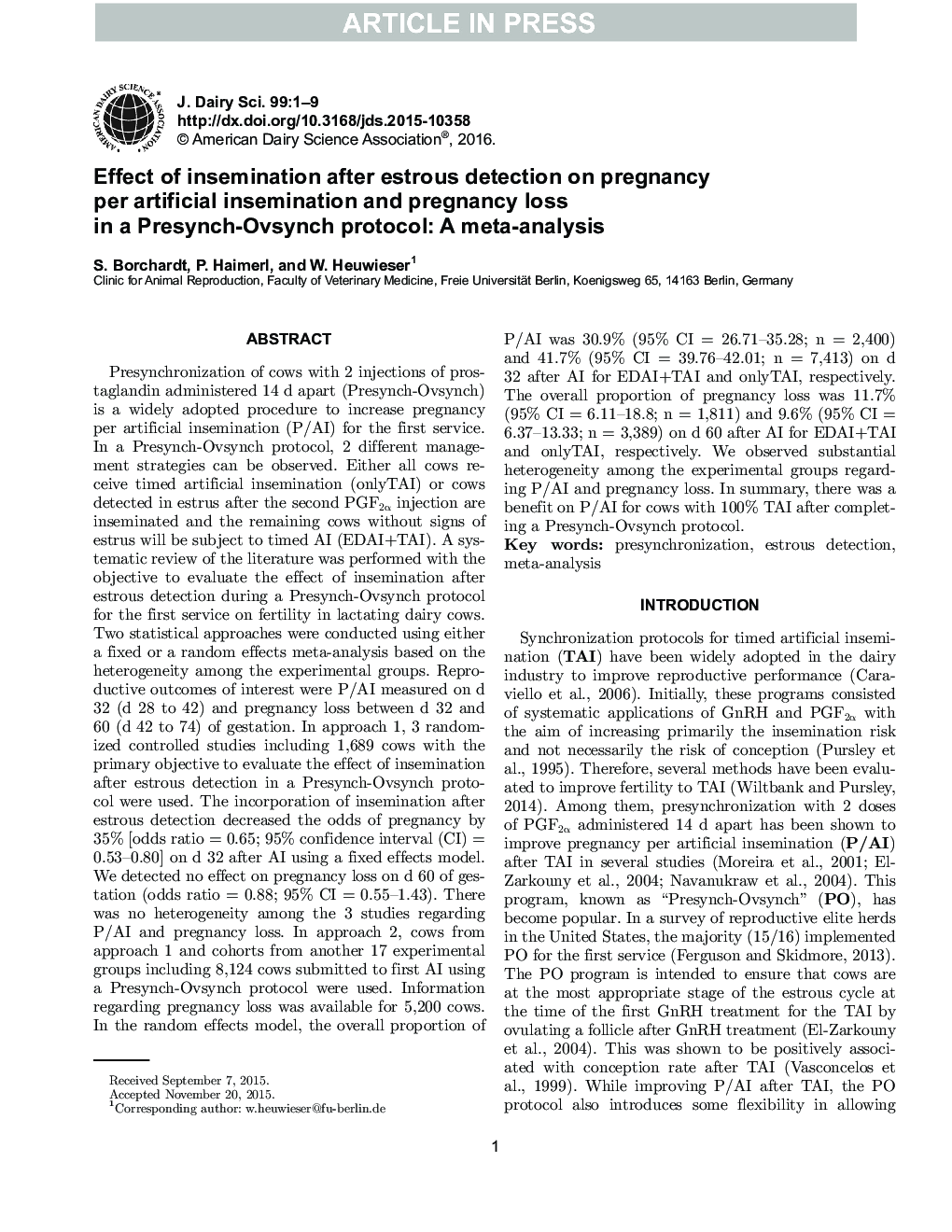| کد مقاله | کد نشریه | سال انتشار | مقاله انگلیسی | نسخه تمام متن |
|---|---|---|---|---|
| 10973257 | 1108012 | 2016 | 9 صفحه PDF | دانلود رایگان |
عنوان انگلیسی مقاله ISI
Effect of insemination after estrous detection on pregnancy per artificial insemination and pregnancy loss in a Presynch-Ovsynch protocol: A meta-analysis
دانلود مقاله + سفارش ترجمه
دانلود مقاله ISI انگلیسی
رایگان برای ایرانیان
موضوعات مرتبط
علوم زیستی و بیوفناوری
علوم کشاورزی و بیولوژیک
علوم دامی و جانورشناسی
پیش نمایش صفحه اول مقاله

چکیده انگلیسی
Presynchronization of cows with 2 injections of prostaglandin administered 14 d apart (Presynch-Ovsynch) is a widely adopted procedure to increase pregnancy per artificial insemination (P/AI) for the first service. In a Presynch-Ovsynch protocol, 2 different management strategies can be observed. Either all cows receive timed artificial insemination (onlyTAI) or cows detected in estrus after the second PGF2α injection are inseminated and the remaining cows without signs of estrus will be subject to timed AI (EDAI+TAI). A systematic review of the literature was performed with the objective to evaluate the effect of insemination after estrous detection during a Presynch-Ovsynch protocol for the first service on fertility in lactating dairy cows. Two statistical approaches were conducted using either a fixed or a random effects meta-analysis based on the heterogeneity among the experimental groups. Reproductive outcomes of interest were P/AI measured on d 32 (d 28 to 42) and pregnancy loss between d 32 and 60 (d 42 to 74) of gestation. In approach 1, 3 randomized controlled studies including 1,689 cows with the primary objective to evaluate the effect of insemination after estrous detection in a Presynch-Ovsynch protocol were used. The incorporation of insemination after estrous detection decreased the odds of pregnancy by 35% [odds ratio = 0.65; 95% confidence interval (CI) = 0.53-0.80] on d 32 after AI using a fixed effects model. We detected no effect on pregnancy loss on d 60 of gestation (odds ratio = 0.88; 95% CI = 0.55-1.43). There was no heterogeneity among the 3 studies regarding P/AI and pregnancy loss. In approach 2, cows from approach 1 and cohorts from another 17 experimental groups including 8,124 cows submitted to first AI using a Presynch-Ovsynch protocol were used. Information regarding pregnancy loss was available for 5,200 cows. In the random effects model, the overall proportion of P/AI was 30.9% (95% CI = 26.71-35.28; n = 2,400) and 41.7% (95% CI = 39.76-42.01; n = 7,413) on d 32 after AI for EDAI+TAI and onlyTAI, respectively. The overall proportion of pregnancy loss was 11.7% (95% CI = 6.11-18.8; n = 1,811) and 9.6% (95% CI = 6.37-13.33; n = 3,389) on d 60 after AI for EDAI+TAI and onlyTAI, respectively. We observed substantial heterogeneity among the experimental groups regarding P/AI and pregnancy loss. In summary, there was a benefit on P/AI for cows with 100% TAI after completing a Presynch-Ovsynch protocol.
ناشر
Database: Elsevier - ScienceDirect (ساینس دایرکت)
Journal: Journal of Dairy Science - Volume 99, Issue 3, March 2016, Pages 2248-2256
Journal: Journal of Dairy Science - Volume 99, Issue 3, March 2016, Pages 2248-2256
نویسندگان
S. Borchardt, P. Haimerl, W. Heuwieser,